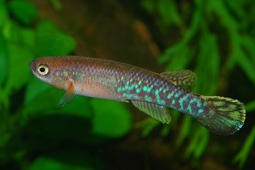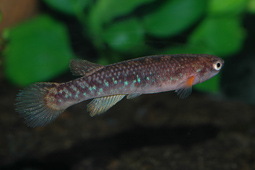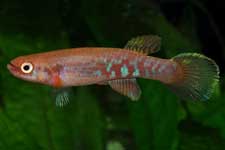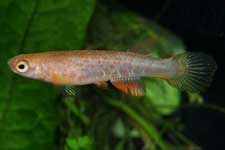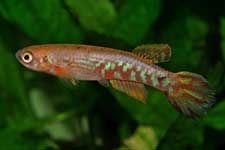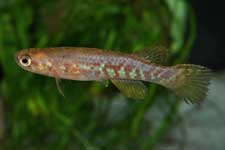History
Alternative name Laimosemion cladophorus.
Reproduction
Keeping and breeding is easy but a tight fitting cover on the aquarium is necessary because their ability to jump, even through the smallest opening, is unbelievable.
This species can, if there is enough space for them, be housed in a tank with more than one male and several females. If separated before and brought together again however, they can be very aggressive towards each other and fight to become dominant to others. The best way to produce offspring is to put a pair or a trio in a small tank of about 10 litres with a small filter in it or with some aeration. On the bottom put some peat moss or dark gravel and a floating "mop" to give an area for laying their eggs. The fish will, if they are given a rich variety of life food, spawn during the whole of their adult life and produce daily between 5 to 15 eggs.
The eggs should be collected by hand and stored for about 14 days in a small container. Eggs are 1.6 mm and amber coloured. It is wise to add some fungus inhibitor to the water you store the eggs in, to prevent the growth of fungus.After hatching the young fry can eat newly hatched artemia nauplii without any problem. It takes 4 to 5 months to raise them to maturity. Often the number of males is far more than the number of females. For some species this can become a major problem for the breeder as he has to raise many young fishes to be able to distribute a few pairs to other hobbyists. Recent personal tests found that lower pH levels during the time of hatching gave a higher percentage of females. To achieve this I used some peat moss that I added to the container with the eggs just before they were ready to hatch. This peat moss also is a good way to prevent eggs from being attacked by fungus.
Their lifespan can be up to 3 years in captivity.
Remarks :
Variations
Map
Meristics
Max. size 5.0 cm.
Dorsal 10.1,
Anal 14.0,
D/A 8.0
LL scale count (average)35
Pre- dorsal length to % SL – 70.1 %
Depth to % SL – 19.0 %
Literature
Huber, J.H. 1991. Revue des Especes de Rivulus de Guyane francaise, avec Descriptions de R. cladophorus n. sp. Rev. fr. Aquariol. Herpetol., 18, (3): 71, fig. 6.
